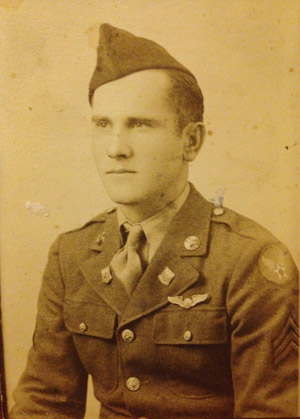

Remember...
James Clifford Pauley
1917-1943
"Wars may be fought with weapons, but they are won by men. It is the spirit of the men who follow and of the man who leads that gains the victory."
General George S. Patton
Staff Sergeant James Clifford Pauley was born to parents James Andrew Pauley (b. 1893) and Elizabeth Julia Thompson Pauley (b. 1886) in Kanawha County, West Virginia, on March 4, 1917. He was one of seven children in a family that included Harold (b. 1915), Vivian (b. 1918), Frances (b. 1919), Everett (b. 1921), Elizabeth (b. 1923), Betty (b. 1927), Ralph (b. 1929), and Odessa (b. 1931). Receiving schooling up through the eighth grade, Pauley returned to work as a farmhand at a young age, taking up residence at the family's new house and farm at Garretts Bend, Lincoln County, West Virginia. As Baptist churches gained a denominational stronghold in Lincoln County at the time, the Pauley family found themselves members of the Elizabeth Baptist Church.
During this time, West Virginia was undergoing changes in its economy as industries developed to support the war. Coal was a major export for the state, as well as lumber and fuel. Due to its vitality as an export, the coal industry had boomed between 1920-1939, and West Virginia became the second largest coal-producing state in the United States. As a result of this, there were four instances between 1919-1921 during which the U.S. Army was called in to resolve labor disputes in the coal mines, the most famous of which was the Battle of Blair Mountain occurring in Logan County.
James Clifford Pauley was born in Kanawha County but moved to, and lived primarily in, Lincoln County. The county was formed from a legislative order in 1867. It is one of West Virginia's youngest counties, being one of only five counties created by West Virginia since the state's formation. Due to its proximity to the Guyandotte and Ohio Rivers, timber became the primary contribution of the county towards the state's economy, followed closely behind by natural gas and oil. Although the county was not a major contributor to the net coal production in West Virginia, many Lincoln County citizens found jobs within the coal mining industry. West Virginia's Lincoln County was hit especially hard by the Great Depression, as roughly 89 percent of the population eventually had to accept governmental aid.
At age twenty-three, S/Sgt. James C. Pauley enlisted in the U.S. Army on October 16, 1940, in Huntington, West Virginia, and was subsequently stationed at Jefferson Barracks, Missouri, for roughly a year. While stationed in Missouri, he took up training as an aerial gunner, specializing in the flying of Boeing B-17 "Flying Fortress" Bombers. As S/Sgt. Pauley learned to operate the B-17, he often moved from place to place.
After completing his schooling, Pauley received his diploma with the highest rank in his class, and was stationed in Salina, Kansas. Once there, he received a leave of absence, which he spent with his parents until he was eventually deployed to England on April 12, 1943.
The mission consisted of three intended elements. On November 5, the initiation of the mission began. A formation of 193 B-17s was dispatched to bomb the railroads and oil refinery in Gelsenkirchen, Germany. S/Sgt. Pauley's aircraft (nicknamed "You Cawn't Miss It") was included in the initial phase of the mission as part of the lead group: the 1st Air Task Force. The 94th Bomber Group launched 31 other aircrafts to carry out the initial phase. Following the bombing of the Polesti oil production center, the oil refinery in Gelsenkirchen became an important component of the German cause.
The second phase was compromised of more bombing runs from a different division, during which three aircrafts were shot down. In the third phase of the mission, a combined effort from the bomb groups was required. Three additional ships were shot down and seven were damaged. During the mission, S/Sgt. Pauley's B-17 was shot down, only one parachute blossoming out of the wreckage and debris, as his aircraft crashed into the North Sea, only 300 yards from Haamstede at Schouwen Island. While in the field, S/Sgt. Pauley, fighting from his position of tail gunner, managed to gun down an enemy plane and ward off ensuing enemy attacks. His actions, while under great pressure, contributed to the success of the mission.
Article prepared by Rachel Morris and Brayden Elswick, George Washington High School Advanced Placement U. S. History
March 2018

West Virginia Archives and History welcomes any additional information that can be provided about these veterans, including photographs, family names, letters and other relevant personal history.